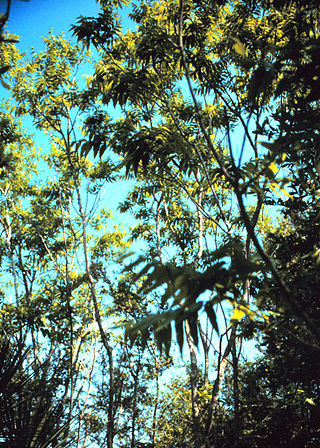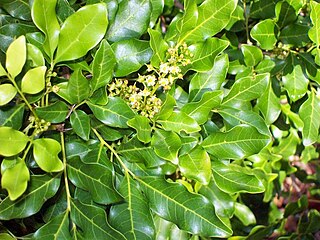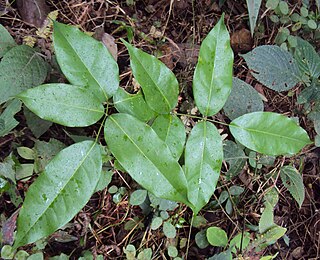
Acanthaceae is a family of dicotyledonous flowering plants containing almost 250 genera and about 2500 species. Most are tropical herbs, shrubs, or twining vines; some are epiphytes. Only a few species are distributed in temperate regions. The four main centres of distribution are Indonesia and Malaysia, Africa, Brazil, and Central America. Representatives of the family can be found in nearly every habitat, including dense or open forests, scrublands, wet fields and valleys, sea coast and marine areas, swamps, and mangrove forests.

Paullinia is a genus of flowering shrubs, small trees and lianas in the soapberry family, Sapindaceae and typical of tribe Paullinieae. It is native to tropical South America, Central America and the Caribbean.

Alectryon is a genus of about 30 species of trees and shrubs from the family Sapindaceae. They grow naturally across Australasia, Papuasia, Melanesia, western Polynesia, east Malesia and Southeast Asia, including across mainland Australia, especially diverse in eastern Queensland and New South Wales, the Torres Strait Islands, New Guinea, the Solomon Islands, New Caledonia, New Zealand, Vanuatu, Fiji, Samoa, Hawaii, Indonesia and the Philippines. They grow in a wide variety of natural habitats, from rainforests, gallery forests and coastal forests to arid savannas and heaths.

The Sapotaceae are a family of flowering plants belonging to the order Ericales. The family includes about 800 species of evergreen trees and shrubs in around 65 genera. Their distribution is pantropical.

Terminalia is a genus of large trees of the flowering plant family Combretaceae, comprising nearly 300 species distributed in tropical regions of the world. The genus name derives from the Latin word terminus, referring to the fact that the leaves appear at the very tips of the shoots.

Sapindus is a genus of about thirteen species of shrubs and small trees in the lychee family, Sapindaceae and tribe Sapindeae. It is native to warm temperate to tropical regions of the world. The genus includes both deciduous and evergreen species. Members of the genus are commonly known as soapberries or soapnuts because the fruit pulp is used to make soap. The generic name is derived from the Latin words sapo, meaning "soap", and indicus, meaning "of India".

Cupaniopsis is a genus of about 67 species of trees and shrubs of the soapberry family, Sapindaceae. They grow naturally in New Guinea, New Caledonia, Australia, Torres Strait Islands, Fiji, Samoa, Sulawesi, Micronesia. Many species have been threatened with extinction globally or nationally, with official recognition by the International Union for Conservation of Nature (IUCN) and several national and state governments.

Harpullia is a genus of about 27 species of small to medium-sized rainforest trees from the family Sapindaceae. They have a wide distribution ranging from India eastwards through Malesia, Papuasia and Australasia to the Pacific Islands. They grow naturally usually in or on the margins of rainforests or associated vegetation.

Toechima is a genus of small to medium-sized trees in the plant family Sapindaceae. The species are native to New South Wales, the Northern Territory and Queensland in Australia as well as New Guinea.

Arytera is a genus of about twenty–eight species known to science, of trees and shrubs and constituting part of the plant family Sapindaceae. They grow naturally in New Guinea, Indonesia, New Caledonia, Australia, the Solomon Islands, Vanuatu, Fiji, Samoa, Tonga; and the most widespread species and type species A. littoralis grows throughout Malesia and across Southeast Asia, from NE. India, southern China, Borneo, Malaysia, Singapore, Indonesia and the Philippines to as far east as New Guinea and the Solomon Islands.

Pseuderanthemum is a genus of plants in family Acanthaceae with a pantropical distribution.

Ludwig Adolph Timotheus Radlkofer, was a Bavarian taxonomist and botanist.
Oncinotis is a genus of plant in the family Apocynaceae, first described as a genus in 1849. It is native to Africa, including Madagascar. As of August 2013 the World Checklist of Selected Plant Families recognises 7 species:
- Oncinotis glabrata(Baill.) Stapf ex Hiern - tropical Africa from Liberia to Tanzania, south to Angola
- Oncinotis gracilisStapf - tropical Africa from Liberia to Central African Republic, south to Angola
- Oncinotis hirtaOliv. - C Africa from Cameroon to Angola
- Oncinotis nitidaBenth. - W Africa from Liberia to Republic of Congo
- Oncinotis pontyiDubard - tropical Africa from Guinea to Uganda
- Oncinotis tenuilobaStapf - C + S Africa from Nigeria east to Sudan + Ethiopia, south to Cape Province
- Oncinotis tomentellaRadlk. - Madagascar
- Oncinotis axillarisK.Schum. = Baissea multifloraA.DC.
- Oncinotis campanulataK.Schum = Baissea campanulata(K.Schum.) de Kruif
- Oncinotis melanocephalaK.Schum. = Baissea myrtifolia(Benth.) Pichon
- Oncinotis subsessilisK.Schum. = Baissea campanulata(K.Schum.) de Kruif
- Oncinotis zygodioidesK.Schum. = Baissea zygodioides(K.Schum.) Stapf

Thouinia is a genus of flowering plants in the family Sapindaceae. The genus is named for André Thouin, a French botanist. As of 2020 Kew's Plants of the World Online lists 27 species in the genus:

Rourea is a genus of plants in the family Connaraceae. They are found worldwide across the tropics and subtropics.

Sapindoideae is a subfamily of flowering plants in the soapberry family, Sapindaceae. It includes a number of fruit trees, including lychees, longans, rambutans, and quenepas.

Matourea is a genus in the family Plantaginaceae. It incudes nine species native to tropical South America and Nicaragua. The name Matourea refers to the town of Matoury.

Calacanthus is a genus of flowering plants belonging to the family Acanthaceae. It contains a single species, Calacanthus grandiflorus. It is endemic to the Western Ghats of western India, in the states Maharashtra, Goa, and Karnataka. It typically grows on moist sunny slopes, including in clumps near streams and on ridge tops, along forest edges, and in shrublands, from 550 to 1,000 metres elevation.

Chytranthus is a genus of flowering plants belonging to the family Sapindaceae. It includes 32 species of small trees and shrubs native to tropical Africa, ranging from Guinea eastwards to Kenya and Tanzania and south to Angola. Most species have a palm-like habit, with large pinnate leaves and unbranched trunks.

Matayba is a genus of flowering plants belonging to the family Sapindaceae.

















